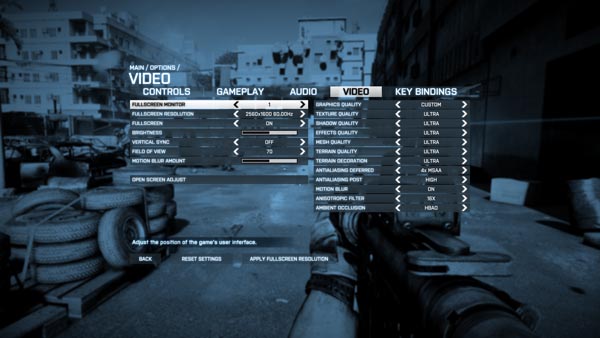How we test - Battlefield 3
GPU comparisons |
|||||||
|---|---|---|---|---|---|---|---|
| Graphics card | Approx. pricing |
GPU clock (MHz) |
Stream processors |
Shader clock (MHz) |
Memory clock (MHz) |
Memory bus (bits) |
Graphics driver |
| Sapphire Radeon HD 6970 Flex (2,048MB) | £299 | 930 | 1,536 | 930 | 5,500 | 256 | Catalyst 11.10 V3 |
| AMD Radeon HD 6970 (2,048MB) | £260 | 880 | 1,536 | 880 | 5,500 | 256 | Catalyst 11.10 V3 |
| ASUS GeForce GTX 580 (1,536MB) | £350 | 772 | 512 | 1,544 | 4,008 | 384 | ForceWare 285.62 |
| ASUS GeForce GTX 570 (1,280MB) | £250 | 732 | 480 | 1,464 | 3,800 | 320 | ForceWare 285.62 |
Test bench |
||||||||||||
|---|---|---|---|---|---|---|---|---|---|---|---|---|
| CPU | Intel Core i7 2600K (3.40GHz, 8MB L3 cache, four-core, LGA1155) | |||||||||||
| Motherboard | Intel P67 DP67BG | |||||||||||
| Memory | 8GB Corsair Vengeance (9-9-9-24-2T @ 1,600MHz) | |||||||||||
| Power Supply | Corsair 430W | |||||||||||
| Monitor | Dell 30in 3007WFP | |||||||||||
| Disk drive(s) | Crucial RealSSD C300 (256GB) | |||||||||||
| Chassis | Corsair Graphite Series 600T | |||||||||||
| Operating system | Windows 7, SP1, 64-bit | |||||||||||
Benchmarks |
||||||||||||
|---|---|---|---|---|---|---|---|---|---|---|---|---|
| Battlefield 3 | 1,920x1,080 and 2,560x1,600 Ultra Quality, with and without 4x MSAA | |||||||||||
| Power consumption | To emulate real-world usage scenarios, we record mains power draw both when idle and whilst playing BF3 | |||||||||||
| Temperature | To emulate real-world usage scenarios, we record GPU core temperature both when idle and whilst playing BF3. | |||||||||||
| Noise | A PCE-318 noise level meter is placed at front of a Corsair 600T chassis with side panel on. | |||||||||||
Notes
We've changed things up for the launch of Battlefield 3, especially as it ships with the card. Rather than show you how a Radeon HD 6970, albeit overclocked, performs in older games, which can be found here, we'd rather know how Sapphire's card shapes up in the eagerly-awaited game. To this end, we've benchmarked it against a standard Radeon HD 6970 2GB and the two competing high-end cards from NVIDIA: the GeForce GTX 570 and GTX 580 - all done on the latest BF3-approved drivers.
The game lets you choose a number of quality presets and we've opted for 'Ultra' quality here; these are high-end cards, right?

Battlefield 3 supports two types of antialiasing. There's regular multisampled AA, referred to as Deferred here, and Post, which takes in FXAA - fast approximate antialiasing. Both can be used concurrently and, subjectively speaking, produce comparable image quality when used on their own. The crux here is that FXAA, set to high, exacts a much smaller performance toll than MSAA - you keep around 90 per cent of the non-aliased frame-rate, compared to 55-60 per cent when using 4x MSAA.
You can click on the 4x MSAA and FXAA image-quality comparisons here and here - we won't tell you which is which - and see if you can easily determine the image-quality difference between the two.
Anyway, we've benchmarked the four cards with Ultra IQ settings and either 4x MSAA or FXAA invoked. The published frame-rates reflect a three-run average when FRAPSing a 30-second section through a frenetic part of Operation Swordbreaker - RPGs, machine-gun fire and general mayhem ensues - and the frame-rate is on the low side for Battlefield 3, giving a worst-case scenario.









